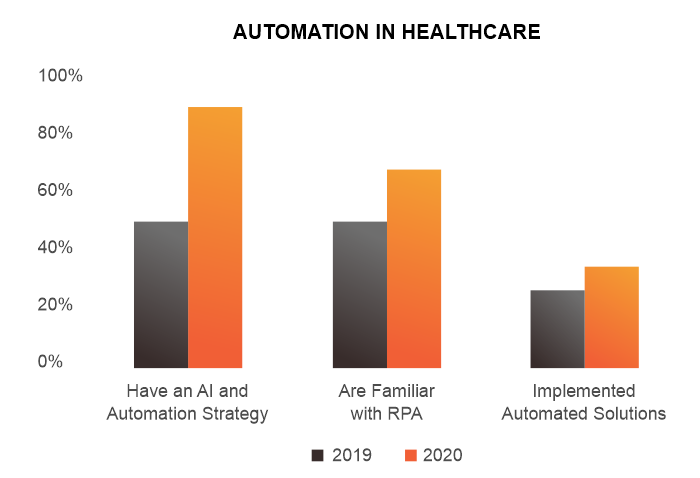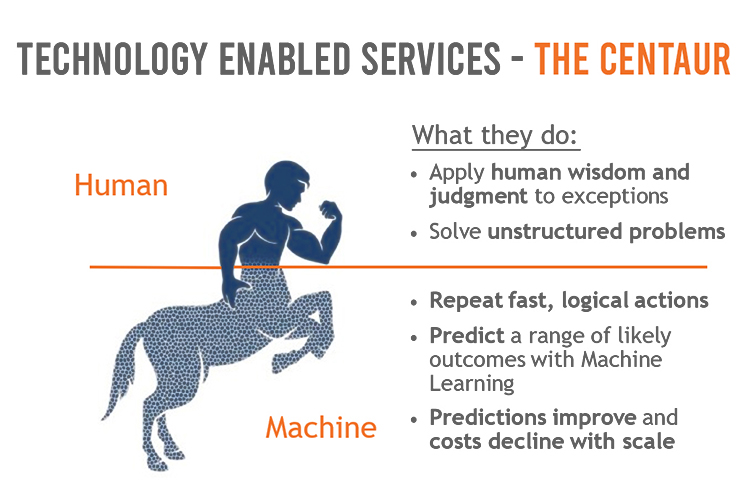Author's Corner
In this white paper, Jeff Shelmire, Senior Vice President, Client Services, explores the power of automation to help improve patient care.
Click on the video to the right to learn more about the author, his paper’s key points, and his motivation for writing on this subject.
To discuss this white paper in more detail, please contact Jeff using the information provided at the bottom of the page.
Are robots taking over the world? New, sophisticated automation built on deep learning, machine learning, and artificial intelligence can produce accurate work at incredible speeds – results that outperform the best human workers. What threats does automation pose and what can I do about it?
According to a survey conducted in 2020, 90% of large healthcare organizations say they have an AI and automation strategy. By comparison, in 2019 this number was 53%. Moreover, 66% were familiar with robotic process automation in 2020, an increase from 50% in the preceding year. *Source: Statistica

The problem
Labor costs continue to increase and, in many cases, it is less costly for businesses to use automation technology instead of humans to perform work. Worker displacement caused by technology is an age-old problem. It is one that can be overcome; however, it requires worker re-training and education.
The opportunity
Automation improves efficiency, production, and quality at lower costs. Simply put, the goal of automation is to improve efficiency by making routine tasks faster to perform, with greater accuracy at a lower cost.
What about my job?
Contrary to popular belief, robots are not replacing humans. Instead, robots are helping humans perform their jobs more efficiently. Firms that can increase production outpace their competitors. Firms that can lower expenses and improve profit margins are able to invest in their businesses and grow them more aggressively. Growing businesses need more employees, not fewer. Thus, automation protects jobs and provides more employment opportunities. Experience demonstrates it is the companies that do not automate that suffer layoffs, not the other way around.
Now, that fact alone says nothing about what happens to the jobs that automation impacts. True, it takes fewer human resources to produce the same amount of work, but humans are still required to oversee and audit the automated processes. It is the workers themselves who are the experts in the processes, not the machines. The machines can only imitate the keystrokes and workflows of the most accomplished users and still need to be programmed, managed, and audited. Therefore, the need for human subject-matter experts remains. The makeup of the job will change because of automation.
Where workers may have once performed largely repeatable and mundane tasks, smarter, better jobs are required to oversee automated processes to make sure they function properly. Without continued oversight of these processes and updates to them as regulation or business requirements demand, they will not work. Therefore, human oversight of automation is required. Workers must be able to adapt and get the required training to manage automation.
By way of example, seventy-five years ago if an irrigation trench needed to be dug, it would have been done by hand, using pick and shovel. Today, individuals can go the local hardware store and rent a Ditch Witch. The Ditch Witch versus the pick and shovel is not much of a race. The Ditch Witch wins every time. It is the human however, who must still operate the "machinery," be it Ditch Witch or pick and shovel. This example may seem overly simplified, especially for tasks involving healthcare; but the concept is the same.
At Vee Healthtek, we use the pictogram (right) to illustrate the demarcation between human and machine. We use the mythological creature, the centaur (half human, half horse) to explain. Humans apply wisdom and judgement to solve unstructured problems which machines cannot handle. Machines are used to repeat fast, logical actions and they can predict a range of likely outcomes using historical data as a basis for the prediction of future events. These projections improve over time as deep learning and machine learning are employed. Even so, human interaction is needed for the outliers, the unstructured data the machine does not know how to process on its own.

Healthcare Back Office Applications
Robotic process automation can perform many of the mundane, routine tasks that medical billers once performed. One area where there is a good dealt of technology adoption is in the use of bots to perform authorization and eligibility checks. This is especially true when eligibility verification and authorizations are conducted via payer portals.
Here is one such case. A large-scale physician group based out of the Midwestern United States wanted to streamline its insurance eligibility and benefit verification process. The company uses fifteen employees to perform the verification process by logging into an application to enter data collected from over thirty insurance websites. This tedious process is repetitive; however, it is also nuanced, based on the unique business rules each payer uses. Different sets of business rules need to be applied for each payer to perform the verification process. The process is time consuming and is highly dependent on the use of human resources.
Using robotic process automation (RPA), this physician group has converted this manual and tedious process to 100% automated. Bots are used to automatically login to the application, retrieve the records and apply the corresponding business rules. The bots also login to the provider’s web portal, perform the necessary checks, and update the information on the client application. This resulted in the physician group reallocating ten employees to other key business areas. The data accuracy level increased to 100% because information was not mis-keyed and the turnaround time of this process drastically improved as bots worked 24 hours per day, 365 days per year (except for periodic, scheduled and routine maintenance).
This case is one example; there are many other applications and uses for bots working in healthcare back-office processes including accounts receivable, payment posting, notice of admission, and simple medical coding.
Automation to Improve Patient Care
We know the more precise and accurate a patient’s health record, the better care they will receive from their care team. Better care starts with better data - a simple concept, but quite complex within the realm of healthcare.
The complexity is due to the intricacy of a patient’s diagnosis, as well as the use of information technology accurately capturing a patient’s precise health circumstance by applying a series of medical codes and free-form notes. With Vee Healthtek, our clients are more effective at providing cohesive and effective care to patients in situations from the simple to the complex.
As the U.S. healthcare system continues its evolution from fee for service to value based care, automation can help improve patient outcomes. Processes that once required massive manpower to perform are now streamlined by using technology. We can use a combination of robotic process automation, deep learning, and machine learning to help our clients perform vital aspects of care coordination and management.
For instance, using technology, we can proactively identify patients who have a risk-factor of falling ill to a chronic condition. Applying the latest technology, we can quickly review years’ worth of a patient’s medical records for diagnostic information indicating health conditions that need to be monitored. Part of this process includes identifying risk-adjusting codes and making certain all diagnostic codes are accurately captured. This process helps in a few ways. It ensures accuracy of a patient’s record so that clinical indicators are correctly captured, it facilitates proper reimbursement from payers, and it enables a better continuity of care. As the patient’s record is improved, so too is continuity of care. The next provider in a patient’s care team can perform better service with better information since every aspect of a patient’s record is up to date and accurate. Again, better data means better, more accurate patient information. Better information means that physicians can provide better care. Better information in a patient’s record also means that care can be better coordinated between multiple providers.
In conclusion, automation is here to stay. It will continue to progress, and its capabilities will continue to grow. Technology enables work efficiency and throughput with fewer errors. Humans are needed to manage the processes and the technologies. The result will be lower costs, faster processing of data, easier healthcare administration, improved care coordination between providers and better health outcomes for patients.

